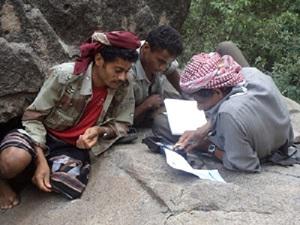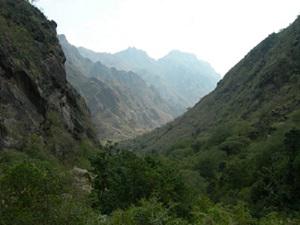David B. Stanton
This project will provide a comprehensive baseline of vertebrate biodiversity (including Arabian leopard presence/absence) in the Jebel Milhan Protected Area. This information will be used to develop a conservation strategy for the protected area and could conceivably result in a management plan.

Nasser with Tawfik (left) and Yousuf (Middle).
The core activity of this project is a year-long camera trap survey covering the most promising areas of the Jebel Milhan Protected Area. The protected area, which was established by Yemeni cabinet decree on November 24, 2010, is heavily populated and as yet has no management plan. Yet, due to the topography of the region and its relatively pristine vegetation, Jebel Milhan harbours a significant wildlife population. We have already documented the presence of Striped Hyena, Arabian Caracal, Red Fox, Small-spotted Genet, White-tailed Mongoose, and Hamadryas Baboon in addition to regionally important avian and plant diversity. Persistent local reports of Arabian leopard and the suitability of the habitat strongly suggest that leopards may continue to use this area.

Prime Leopard Habitat in Wadi Shaharah, Jebel Milhan Protected Area.
In reconnoitring the Protected Area, principal researcher Mr. Nasser Qassim will establish contacts with community members and gather information from stakeholders regarding local knowledge, attitudes, and practices in relation to Arabian Leopards and other wildlife. If he finds any direct evidence of leopard presence (e.g. scat, scrapes, footprints, etc.) Nasser will photograph the evidence and collect samples as appropriate. During the course of this study it is certain that Mr. Qassim will collect records of other species which trigger his trail cameras. Data collected will be analysed to provide population estimates of the various species photographed with the main focus, of course, being the critically endangered Arabian leopard.
The ultimate goal of the project, beyond defining the status of Arabian leopards at Jebel Milhan, is to strengthen local commitment to conservation in the protected area, and to use the information collected to develop a conservation strategy for the protected area. In time, and with additional resources, it is conceivable that the study will contribute to the drafting of a management plan for the Jebel Milhan Protected Area.